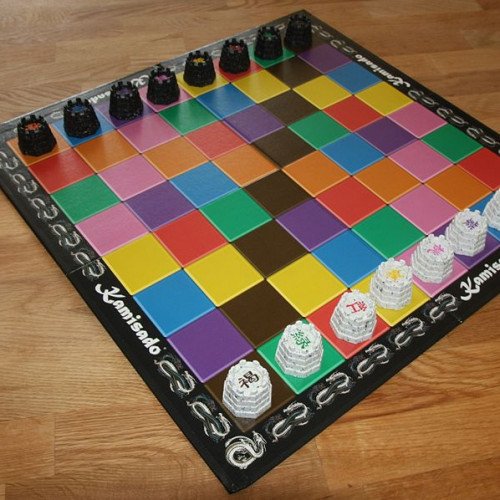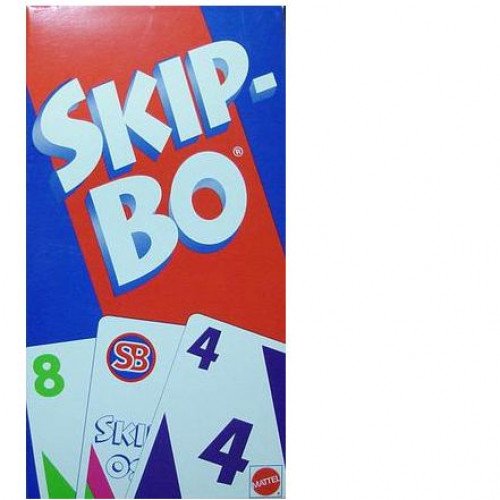KAMISADO VS SKIP-BO

KAMISADO
Kamisado is an abstract strategy board game for two players that's played on an 8x8 multicoloured board. Each player controls a set of eight octagonal dragon tower pieces. Each player's set of dragon towers contains a tower to match each of the colours that appear on the squares of the board (i.e., a brown tower, a green tower, etc.). One player's towers have gold dragons mounted on the top, while the other player's towers are topped with black dragons. In an interview, designer Peter Burley said that the design of Kamisado dated back to a chance observation in a men's room in the 1970s. "I noticed that the floor had an interesting pattern of small colored tiles", he said. "I mentally made a note that this could possibly be used as a basis for a board game – this is something that I do quite a lot, whenever I see something a bit different. It must have made a deep impression on this occasion, however, because that night I had a vivid dream involving this tile pattern, and somehow the notion of 'whatever colour you land on, your opponent must move a piece that matches this'. I guess my subconscious mind had been working on this and sorted it out while I was asleep." The players’ towers start the game on the row nearest to them. The players take turns moving one tower any number of spaces in a straight line, either directly forwards or diagonally forwards, but not into or through a square already containing another dragon tower. The player with the black dragons moves first and may choose any tower. From this point onwards, each player must move the dragon tower that matches the colour of the square that the opponent's last move finished on. The object of the game is to reach your opponent's Home Row with one of your dragon towers. The first player to achieve this goal is the winner of the round. Games may be played as single rounds, or as more advanced ‘Match’ formats. Matches are played up to 3 points (Standard Match), 7 points (Long Match) or 15 points (Marathon Match). During a match, each time a round is won, a special ‘Sumo Ring’ is added to the dragon tower that has fought its way through to the opponent's Home Row. The sumo rings provide the scoring system for the game, and also endow special powers to the dragon towers that carry them. These towers are known as Sumo towers and have the ability to push opponent's towers back one space, by using a move known as a ‘Sumo Push’.
Statistics for this Xoptio

SKIP-BO
Skip-Bo is a commercial version of the card game Spite and Malice, a derivative of Russian Bank (also known as Crapette or Tunj). In 1967, Minnie Hazel "Skip" Bowman (1915–2001) of Brownfield, Texas, began producing a boxed edition of the game under the name SKIP-BO. In 1980 the game was purchased by International Games, which was subsequently bought by Mattel in 1992. A mobile version of the game for iOS was released by Magmic in September, 2013. There is a new version called "SKIP-BO Mod" that comes in a white and blue case. Two to four people can play at a time as individuals, or, six or more players in teams (no more than three partnerships). The object of the game is to be the first player or team to play out their entire stock pile(s). The player with the middle age goes first. Each player is dealt 30 cards (recommended 10-15 for faster gameplay) for their pile with only the top card visible, and a hand of five cards, and the remaining cards are placed face down to create a common draw pile. The shared play area allows up to four build piles, which must be started using either a "1" card or a Skip-Bo, and each player also has up to four personal discard piles. Each turn the active player draws until they have five cards in hand, though there are cases of not drawing more cards to equal five cards, instead doing a draw of a certain number of cards. They must play either the next card in sequential order or a wild Skip-Bo card, using either cards in hand, the top card of their stock pile, or the top card of any of their four discard piles. If the player can play all five cards from their hand, they draw five more and continue playing. When no more plays are available, the player discards one card to either an empty discard pile or on top of an existing one and play passes to the next player. When a build pile reaches 12, it is removed from the board and that space becomes empty for another pile to be started; play continues until one player has played their final start card.